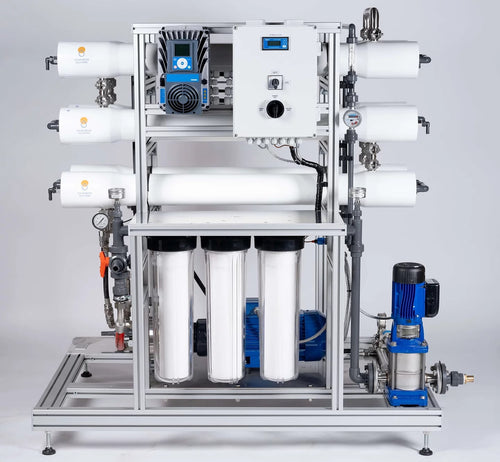Water for stock - setting up a dam pump
When we have cattle in our stock yards set up water troughs in the yard, which we fill from a nearby dam using a firefighter pump. This is how we set up the pump suction and discharge when pumping from a farm dam to a water trough.
There is a dam just near the stock yards, so we decided to install two 1000 L troughs and fill them from the dam using our dam pump. In Australia, this type of pump is known as a "firefighter" pump, I don't know if that term is used in other countries as well. It can be used for rural firefighting as you can just dump it into any dam, tank or swimming pool and suck out the water at a high flow rate. It has a petrol engine, so it can be used anywhere, even if there's no electricity connected. We usually leave it sitting next to the dam at "eight acres" so that we can pump water up to various troughs and old bathtubs that we use for stock water, but as we didn't want to buy a second pump, we put it on the ute and took it to the new property to fill the troughs. It will live on the back of the ute while we need it at both properties.
| The dam pump |
| The dam is pretty good for swimming too, Chez loves a swim (more of a wade, I call her my hippo), but Chime is a bit more hesitant. |
To set up the pump we installed a foot valve on the suction pipe (this keeps the water in the suction line and prevents large debris being sucked up with the water), with a rock to keep it under the water and a float to keep it from sitting on the bottom and sucking up mud, all tied on with baling twine. Once we had the suction end set up in the dam, we just attached the discharge fittings and started the pump. After we'd filled the troughs, we disconnected the pump and left the two sections of polypipe ready for the next time we need to fill the troughs and took the pump back to the other property.
| Farmer Pete demonstrates the float/sinker idea, the float string turned out to be ambitious and was shortened |
| We couldn't throw it far enough from the shore, so I 'volunteered' to wade in, I kept my boots on! (Cheryl did come in for moral support) |
| The suction end all set up |
| filling the troughs in the yards |
Have you set up stock water? What method do you use?




















Paul – not we don’t filter the water, its just suspended clay, extra minerals for the cattle (apart from that, the water tests very clean, basically just rain water). The dam on our previous property was very clear – due to the salinity of the water, and the water was no good for cattle, so I’d rather see dirty water now!
Raymond – thank you for sharing your experience, that sounds like a very good system.
I see the water is very muddy. Do you have any plans to filter it for stock use?
Our water also has a lot of clay in suspension and it never settles out so I am wondering what I can do about it.
Hi Liz
I like your post. I have a farm on the NSW Mid North Coast and raise about 60+ commercial Angus breeders. In two of my paddocks I do something similar to you with the fire pump. I pump the water from a dam to a 20K litre holding tank. From there the water is gravity fed down to four water troughs. I have valves in the system to control which water goes to which trough so as to not waste the water when no cattle are grazing in that grazing cell. I use one trough for two grazing cells to save the expense of added troughs, pipe and valves. Each cell is divided by temporary electric fence braid. I have a bit of elevation that allows me to use gravity to feed each trough. Each trough is fitted with a float valve that shuts the feed of water down when the trough fills and the float rises.
This system is very economical and convenient for me to run . The 1.5 inch ag pipe is run along the fence line to the tank from the fire pump and only a small portion of the pipe is above ground off the main water line.
Your site is great and I really enjoy reading it.
Cheers,
R.
Leave a comment